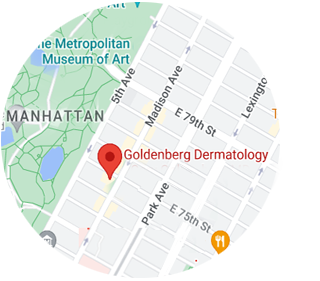Dr. Goldenberg Quoted in “Cystic Acne–The Acne Bad Boy” on No Nonsense Beauty Blog
Cystic Acne–The Acne Bad Boy by Deb Chase
There is acne and then there is cystic acne. Raised, painful and hard to treat, cystic acne is more common in men than women. Its not a short term problem, usually starting in the teens and continuing for decades. The differences between cystic acne starts blow the surface of the skin. The oil gland is connected to the hair follicle.( In the diagram the long structure is the hair follicle and the small blobs on the side are oil glands).When the small oil gland fills with excess oil and dead skin cells, it forms first a black head and then the classic whitehead on the surface. If the hair follicle becomes clogged with oil and skin cells, the entire structure swells. This is a cyst and if it bursts below the skin this severe inflammation can damage the collagen leading to scarring.
The Cause of Cystic Acne
Cysts tend to run in families so if you hve cysts, you can probably blame Mom or Dad. Cystic acne starts when elevated testosterone levels triggers a significant increse in oil gland activity. The larger amounts of oil clogs the pores and fills up the hair follicle. This increased oil encourages the growth of P. acne bacteria which triggers inflammation and breakouts.
Treating Cystic Acne
The standard topical treatment for acne that combines salicylic acid, benzoyl peroxide, antibiotics and even topical Retin A will not get the job done in cystic acne. None of these medications slow down out of control oil glands that are the driving force behind cystic acne. For this bad boy, acne specialist Dr Gary Goldenberg prescribes the “big dog”– the oral form of Retin A known as Isotretinoin.
Isotretinoin ( aka Accutane)– The Acne Drug People Love to Hate
Isotretinoin attcks acne on three levels– its shuts down oil gland production, decreases inflammtion and dissolves the cell and oil debris clogging the pores. This highly active medication is not without its problems. The shut down of oil glands leads to chapped lips and dry eyes while headaches and muscle aches have also been noted. There are anecdotal reports of drepression and suicidal thoughts. The most serious problem with Isotretinoin is its link to birth defects. Unfortunately the young woman of child bearing age is a likely user of Isotretinoin. To prevent tragic problems, it is essential to use not one, but two different forms of contraception when using Isotretinoin.
The first and most famous brand of Isotretinoin was Accutane. Due to reports of serious side effects, Roche no longer distributes this medication. The void is filled by lower cost generic versions as well as new forms with additional benefits. For example, the original Accutane works best when taken with a high fat, high calorie meal. For diet concious women this was often a non-starter. Mount Sinai based dermatologist Dr Goldenberg now prescribes a new form of Accutane called Ascorbia that does not need a big meal to deliver results.
Cystic Acne Treatment Plan
If you are on Isotretinoin you need a mild cleanser like Cetaphil or CeraVe Foaming Facial Cleanser. If the skin feels dry or irritated Dr Goldenberg recommends a ceramide rich product like CeraVe Facial Moisturizing Lotion PM. Not only does the moisturizer relieve dryness, the skin seems to respond better to Isotretinoin with extra ceramides. When using Isotretinoin you need to avoid peels, glycolic acid products, scrubbing grains, or cleansing brushes. Isotretinoin makes your skin more sensitive to sun damage so you need a strong, yet non irritating sunblock like CeraVe Moisturizing Lotion SPF30 or Neutrogena Healthy Defense. While on Isotretinoin you will need monthly blood tests to monitor liver function as well as cholesterol and triglycerides which tend to rise on Isotretinoin.
After a standard 4-6 month course of treatment, 80% of both men and women are ‘cured” of cystic acne. In some cases a second curse is needed to get cystic acne under control.
Isotretinoin Alternatives for Cystic Acne
If you absolutely cannot tolorate Isotretinoin, there are two alternatives. For women, hormonal therapy such as Ortho tricyclin can calm over active glands. For both men and women photodynamic therapy uses a specific form of blue light to attack bacteria that are driving the formation of cysts. Here’s how it works: A photosensitizing agent such as Levulan is applied to the skin for 17 minutes. Then the treated skin is exposed to a blue light. The cells take-up the medication and once in the cells, the light literally kills both the oil glands and the bacteria which are triggering acne breakouts. A series of three-eight treatments are needed before photodynamic therapy will bring cystic acne to its knees. However its not covered by insurance and acne treatment with photodynamic therapy will mean an out of pocket bill of $1000 per treatment.
One final thought: Cystic acne usualy leaves scars and in a follow-up post Dr Goldenberg and I will explain how the three types of acne scars are formed and the best treatment for each. Cystic acne is a big tough problem, but there are even bigger solutions.













Leave a Reply
Want to join the discussion?Feel free to contribute!